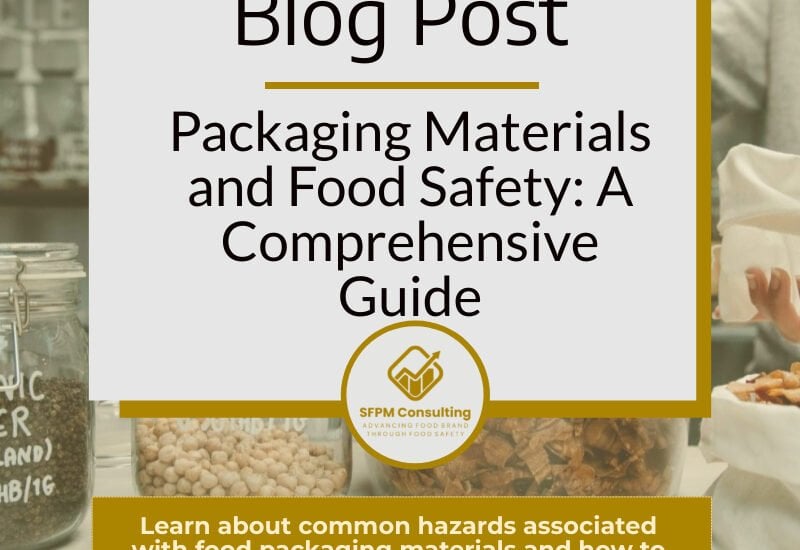Packaging Materials and Food Safety: A Comprehensive Guide
- February 14, 2023
- Posted by: Felicia L
- Category: Food Safety

Packaging Materials and Food Safety: A Comprehensive Guide
Food packaging materials play an important role in protecting food from spoilage and contamination. This blog discusses the different types of food packaging materials, how they protect food from spoilage and contamination, the different types of contaminants that can be present in food, how food packaging materials affect the quality, safety and nutritional value of foods, as well as tips on evaluating food packaging materials for safety and efficacy.
-
What are the different types of food packaging materials?
There are various types of food packaging materials, each with its benefits and drawbacks.
Some common types of food packaging material include:
1) Paper-based packaging materials include paperboard, bakery boxes, and shrink wrap. Paper-based packaging is affordable, easy to clean and recyclable, but it can be less durable than other food packaging materials. It’s also not typically resistant to moisture or bacteria leakage.
2) Plastic-based packing such as polyethylene terephthalate (PET), high-density polyethylene (HDPE), linear low-density polyethylene (LLDPE), PVC films, and PE foams. These plastics offer several advantages over paper-based packing, including resistance to moisture and bacteria infiltration and being lightweight enough that they don’t affect the flavour or texture of foods during transport or storage.
-
How do food packaging materials protect food from spoilage and contamination?
To protect food from spoilage and contamination, packaging materials must prevent moisture, oxygen and other contaminants from entering the package.
Packaging materials can be classified according to their protection capability: barrier, occlusive and absorbent.
The most common type of food packaging material is the barrier film which uses a plastic or metal sheet as its main component. Barrier films block water vapour, air pollutants and other molecules that might damage the contents of the package while remaining flexible enough so that it does not impair product quality or taste. The use of barrier films has greatly increased in recent years due to their ability to keep foods fresh for longer periods without preservatives (which are often harmful), as well as prevent microbial growth between packages during transport or storage.
Occlusive materials such as chocolate milk cartons have an ingredient called polyethylene glycol (PEG) that coats the inside of the carton walls like Vaseline jelly. This prevents liquid foods from being absorbed by paperboard and making contact with edible products below – thus inhibiting bacterial growth and extending shelf-life. In addition, PEG helps retard staling caused by oxidation reactions on fruits, vegetables etc., leading to a more pleasant flavour experience.
Absorbent gels can play an important role in preserving stored foods because they trap liquids within their molecular structure. When properly designed, these gels do not disintegrate even at high temperatures; this preserves the food’s texture and flavour.
-
How do food packaging materials affect food quality, safety and nutritional value?
Packaging materials are essential in protecting food quality, safety and nutritional value. They can affect these factors in a variety of ways:
1. Food packaging material affects foods’ taste, smell and appearance. Materials like plastics, paper or waxes can change food items’ flavour, fragrance and texture profiles.
2. Food packaging material can impact how nutritious foods are. For example, wrappers that protect fruits or vegetables from exposure to air may reduce their nutrient content. Food packaging material can also affect how heat is transferred to food. For example, films containing oil or fat may create a barrier between the food and the air, slowing down the rate at which heat is released from the food. This could result in foods being overcooked or undercooked.
3. Packaging material may also affect the environmental sustainability of food production systems. For example, using recycled materials can help to conserve resources while reducing emissions associated with manufacturing new products.
4. Finally, food packaging material has an impact on human health. Styrofoam packing materials used as nut-based stuffing alternatives might increase the risk for some allergic reactions due to cross-reactivity between different proteins found in nuts.
-
What are the different types of contaminants that can be present in food packaging materials?
Packaging materials can contain a variety of contaminants that can be harmful to human health. Here are three types of contaminants that commonly appear in food packaging materials:
- BPA (Bisphenol A) is an endocrine disruptor linked to cancer, obesity, and other diseases. It’s often used as a plasticizer in food packaging containers and the lining of canned goods. Some brands have started using BPA-free cans, but it’s still common to find products with this contaminant. There are many ways to reduce your exposure to BPA. Avoid using plastic food packaging and canned goods with polycarbonate lining or other hard plastics. If you can’t avoid these products, try to buy brands that use BPA-free cans or containers. You can also recycle old plastic bottles and containers if they can’t contain contaminants.
- Phthalates are chemicals found in many plastics that can act as sex hormones or birth controls in humans; they’re also known to cause reproductive problems and developmental issues at high doses. They’re often used to make these materials more durable and flexible, but they also affect humans and the environment.
Some phthalates are known to cause reproductive problems and developmental issues at high doses. Phthalate levels in some of these products can be quite high, meaning people who consume them regularly could have adverse health impacts.
- PVC (polyvinyl chloride) is a cheap material often used for water bottles, soft drink cans, milk cartons, fast food boxes, sandwich bags, etc. The problem with PVC is that it doesn’t biodegrade well – which means it pollutes waterways and our oceans over time. The problem with this is that PVC isn’t very durable – so if it’s damaged or broken, it can be difficult to recycle. Additionally, because PVC is cheap and often used in disposable products like water bottles and fast food boxes, manufacturers don’t have much incentive to find ways to make the material more environmentally friendly.
-
How does evaluating food packaging materials help ensure food package safety and efficacy?
Packaging materials play a significant role in the safety and efficacy of food packaging. They can help preserve food quality, increase shelf life, affect colour, taste and nutritional value, and prevent pests and moisture from entering the food. Evaluating these various factors helps ensure that your packages are safe for consumers.
When selecting packaging materials, we must follow these steps:
- Determine the intended use for the food packaging materials.
Food packaging materials can be divided into two categories: food-grade and general-purpose. Food-grade packaging materials are specifically designed for the safe storage, transportation, and consumption of food. These materials must meet stringent safety standards set by the FDA and USDA.
General-purpose packaging materials are not intended to store or transport food. Still, they may be used for other purposes, such as shipping products in bulk or protecting products during storage or distribution. It is important to determine the intended use of the food packaging material before selecting it because some types of packaging may not be appropriate for certain applications. For example, plastic wrap is not typically used to store food because it does not protect foods from contamination or spoilage.
We must understand clearly how we intend to use the packaging materials -what type of plastic materials are suitable for our needs. Consider the packaging materials’ properties.
- Review food packaging materials specifications and food safety approval.
The material specification is what type of plastic and coating will the kind of plastic and coating be used in the packaging.
At the same time, food safety approval determines whether that particular type of plastic and the coating can withstand high temperatures and chemicals. To ensure that your food is safe when it reaches your table, you must review both specifications carefully. Here are a few things to keep in mind:
- The material specification should specify which types of plastics and coatings can be used safely with high temperatures and chemicals.
- The food safety approval should determine whether those specific materials meet all necessary safety standards.
- Make sure that the material specification matches the intended use of the packaging; for example, if you’re using biodegradable packaging for composting purposes, make sure that the specified plastic or paper is biodegradable.
- Check whether any special processing steps are required before using a particular package; for example, some plastics may require an autoclave before they can be used in hot foods.
The use of the food packaging materials must also meet the local food packaging regulations -this information may be presented in the form of a letter of no-objection, a letter of guarantee or a letter of assurance from the supplier.
- The packaging materials must be tested to ensure that they meet the specifications and can be used in the processing equipment before approval and purchase.
Conclusion
In this blog, we briefly discussed the different types of food packaging materials, how they protect food from spoilage and contamination, the other contaminants that can be present in food, how food packaging materials affect the quality, safety and nutritional value of foods, and how evaluating food packaging materials helps to ensure proper safety and efficacy of food packages. We hope that you found it helpful. If you have questions or comments about how to evaluate your food packaging supplier, email us at info(at) sfpmfoodconsulting.com. We would love to hear your thoughts.
